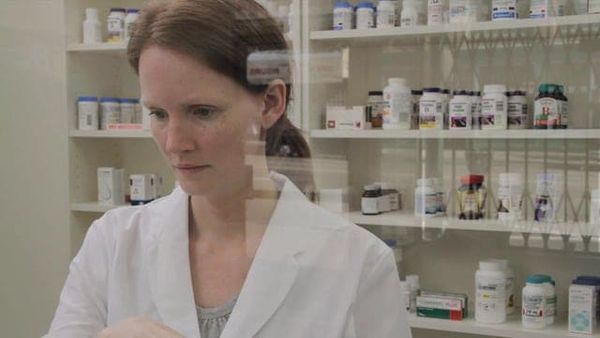Eye For Film >> Movies >> East Hastings Pharmacy (2012) Film Review
East Hastings Pharmacy
Reviewed by: Michael Pattison

Directed by Antoine Bourges and associate produced by Tower director Kazik Radwanksi, East Hastings Pharmacy depicts the daily rituals of a methadone clinic in Vancouver’s Downtown Eastside, and the unique relationship that forms therein between pharmacist and patient. Though it never leaves the interior of its intimate, eponymous setting, the film’s even-paced rhythm and observational style, in which a string of characters come and go and come again, has more than a few hints about the social and political implications of not just the Canadian government’s drugs policies but the methadone programme in general.
As an opening text-card tells us, when someone is prescribed methadone they must attend a pharmacy that is open every day of the week. In most cases, the prescription will indicate that the dose is to be dispensed daily and that the pharmacist must witness its consumption. The resulting image, as is made immediately clear by this understated days-in-the-life-of study, is of women and men queuing for their turn at the glass pane before them, behind which stands a pharmacist (Shauna Hansen), the sole face of authority upon whom their rehabilitation has come to depend. As one patient discovers, though, as she argues to have her “carry” privileges reinstated (which would allow her to take her methadone out of the clinic and consume it elsewhere), all power resides on the other side of the transparent screen. Furthermore, the pharmacist herself has little power; she extends understanding and sympathy, but her position within an unseen hierarchy precludes anything beyond that.

To emphasise the disconnect, Bourges films from immobile vantage points on both sides of the glass divide, Lindsay George’s cinematography making effective use of its reflective screen. Though the fixed-camera set-ups and shot/reverse shot patterns Bourges employs make it apparent that the film is indeed “directed” as opposed to merely documentarian (Hansen is a fashion model and actress), the patients’ emaciated cheeks and toothless grins are clear signs of real-life abuse. Their willingness to appear in the film, in fact, plays a large part in its overall power, since they lend an authenticity to their interactions with Hansen’s pharmacist and with each other.
With its considered compositions and emphasis upon real-life re-enactment, East Hastings Pharmacy has a vague resemblance to Soderbergh’s Bubble (2005). Like that film, Bourges’ work evinces an anywhere-anytime feel despite its geo-specific title, its concentrated setting doubling as some kind of metonym for the wider social fabric. Evidence of a world beyond these doors is there in the few references patients make to their pasts, to their home lives and to their other responsibilities. But it’s also there in an audio-visual juxtaposition similar to those politicising soundbites in Killing Them Softly: on the small, wall-mounted television watched by patients while waiting for their methadone to be prepared, we hear history lessons and American military adventures; as this Canadian film quietly demonstrates, any drugs intervention programme must resist all war-zone logic and militarist rhetoric if it is to effectively treat those vulnerable many so in need of compassion and understanding.
Reviewed on: 15 Apr 2013














